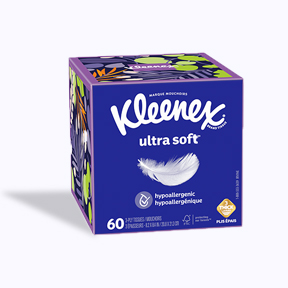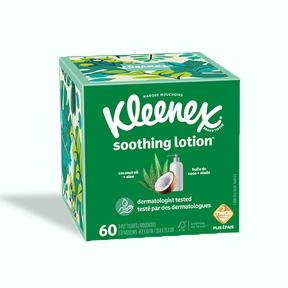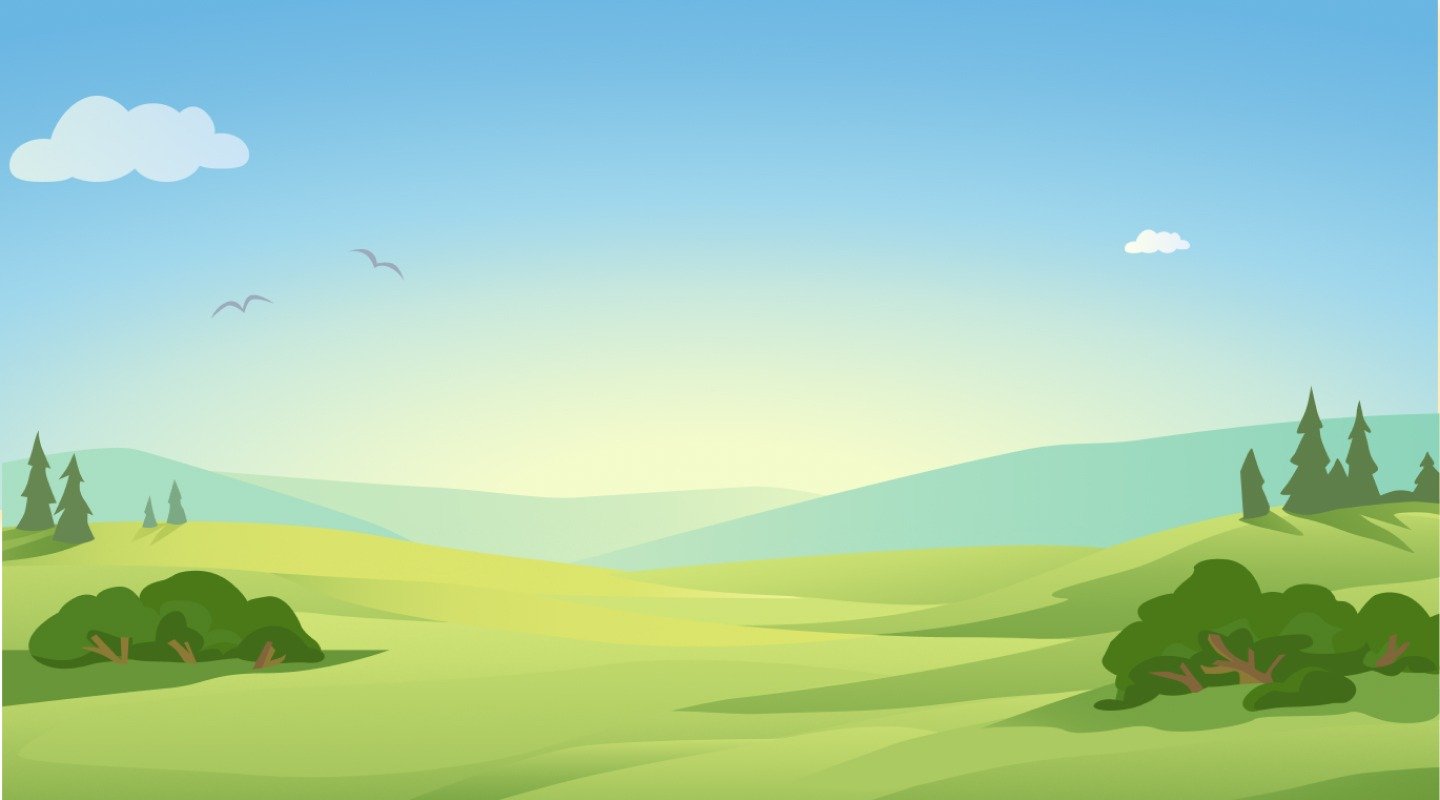


Click here to sign up for alerts
Tap here to sign up for alerts

The pollen forecast for your area
The weather forecast for your area
Discover our hay fever advice and more information about pollen in your area.

Get ahead of pollen with personalized alerts!
Sign up for pollen alertsPollen Count in Toronto, Ontario
What is the pollen count in Toronto today?
Planning your day but don’t want pollen to get in your way? Then enter your postal code in Your Pollen Pal above, designed to show you the daily pollen count in Toronto.
Pollen Forecast for Toronto
Check how your hay fever could be affected with Your Pollen Pal – giving you an accurate pollen count in Toronto for the days ahead. Whether you’re strolling around the grounds of Casa Loma or planning a picnic with pals in High Park, track pollen levels so you can be prepared with a pocketful of Kleenex® Ultra facial tissues.
Pollen Month-by-Month in Toronto
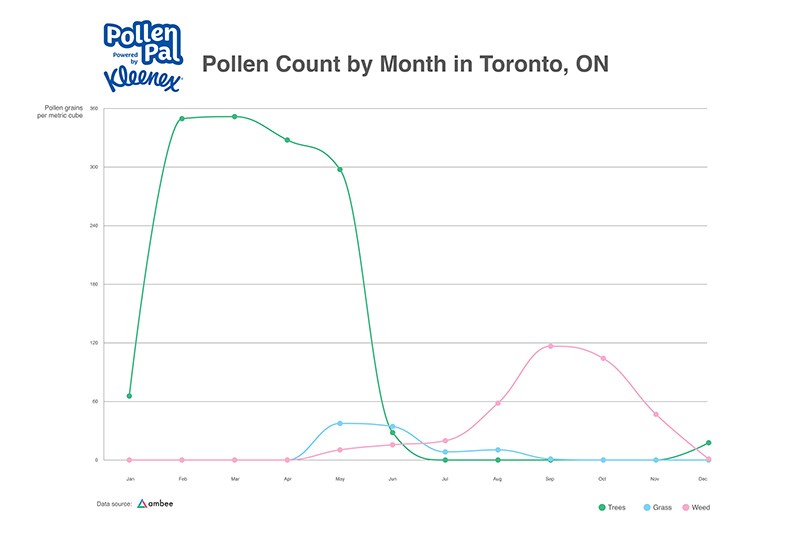
-
January
-
February
-
March
-
April
-
May
-
June
-
July
-
August
-
September
-
October
-
November
-
December
With snow covering most of Toronto, this month has a low pollen count. Allergies in January are most likely mold or pet related. Having trouble distinguishing between hay fever and a winter cold? Check out our guide to find out the differences.
So long as the freezing temperatures continue in Toronto, pollen rarely makes its presence felt this early in the year.
The first month of spring brings with it the beginning of tree pollen season. Trees in season include Cedars, Hazels, Alders, Elms, Maples, Willows, Poplars, Pines and Oaks.
April showers bring… grass pollen?! Welcoming Kentucky grass, the first representative of the upcoming grass pollen season. Toronto’s Mulberry and Walnut trees come to life again this month.
Sycamore trees begin pollenating in May. Kentucky, Bermuda, Johnson, Orchard, and Timothy grasses are spreading their pollen evenly across Toronto.
By June, pines, birch and oaks are the primary producers of tree pollen. Sweet vernal joins the party and adds its pollen to the other grasses.
In July, grass pollen is peaking in Toronto while the majority of tree pollen production is coming to an end for another year.
The good news is that tree pollen production has peaked with the exception of a few late bloomers. Grass pollen is also on its way out. In Toronto, ragweed is now the dominant pollen producer, along with dock, nettle, mugwort and plantain.
Ragweed is on the decline, signaling that hay fever season is finally winding down. Feel free to take a deep breath without causing any runny noses or itchy eyes – and hope that the sun sticks around to make the most of it!
With any luck, the last of the weed pollen is on its way out, although some ragweed along with crab grass may hang around until the first frost of winter in Toronto.
Enjoy the changing leaf colours without your eyes watering: November’s pollen count tends to be low, along with the temperature.
December brings the first official day of winter in Toronto, which means traditionally low levels of pollen for the next few months.
Top Causes of Pollen in Toronto
Trees produce pollen in Toronto from March until July. Toronto’s most common tree allergens are Birch trees, Mulberry trees, Hickory trees, and Poplar trees.1 Grass pollen is in the air from April until July as well, followed by weed pollen. Ragweed pollen is the dominant strain in Toronto, beginning in August through September (or until cooler temperatures take over).
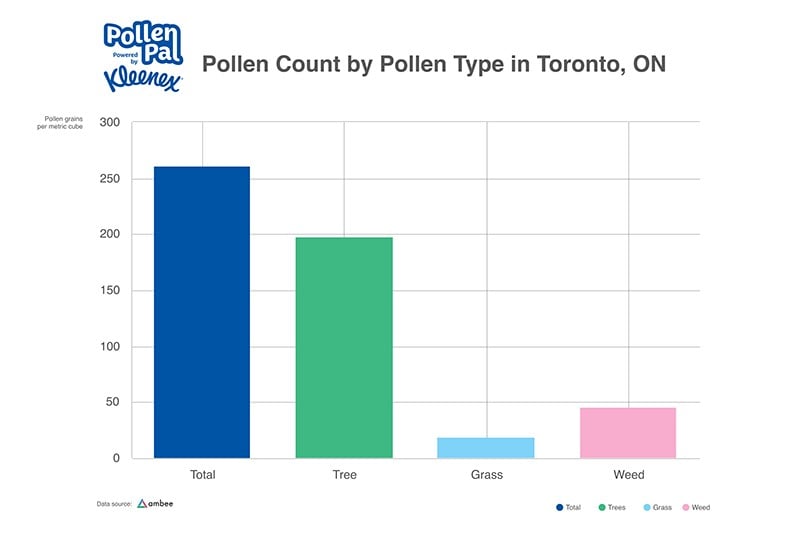
How to Stay Prepared for Toronto’s Allergy Seasons
- Always have a package of Kleenex® Ultra On-the-Go 3-Ply Pocket Facial Tissues on hand to comfort your runny or stuffy nose whenever seasonal allergies my strike.
- Wear sunglasses to stop pollen reaching your eyes to prevent watering.
- Wash your hands frequently while out and about to remove pollen.
- Try using petroleum jelly around your nostrils and on your upper lip to trap pollen.2
- Try wearing a highly protective comfortable mask to filter out pollen and other allergens in the air.3
- When possible, change your clothes and shower to wash off and remove pollen upon returning indoors after spending time outside.
- For anyone looking for a natural solution, nasal breathing exercises have been shown to assist those using the standard nasal sprays.4
Pollen Hotspots in Toronto
While the Toronto skyline may be dominated by skyscrapers, capped off by the CN Tower, but the city also has many green spaces, from Queen’s Park to Trinity-Bellwoods and the 400-acre High Park. Check in with Your Pollen Pal to assess the pollen levels before you make plans to rent that quadricycle on Toronto Island you and your friends have been wanting to try.
Allergy Friendly Activities in Toronto
As the most populous city in Canada, Toronto boasts a huge range of attractions. From The CN Tower to its many art galleries and museums, there are plenty of amazing indoor attractions to keep you busy on high pollen days. Discover your local pollen forecast with our pollen tracker to know what type of pollen count to expect. During high pollen times, why not pre-book tickets to some of the city’s best-loved attractions to make sure your plans are organized.
Cultural Sites
Whether you’re considering the EdgeWalk or a more sedate reservation in the 360 restaurant, the CN Tower is Toronto’s most famous and recognizable landmark. It’s not the only place to visit though between hockey memorials and notable markets, what's not to enjoy?
- CN Tower
- Hockey Hall of Fame
- Art Gallery of Ontario
- Kensington Market
- St. Lawrence Market
- Casa Loma
Indoor Activities
Bringing the kids out for the day? Try any of these interactive exhibitions that are sure to thrill and entertain them (and you!):
- Royal Ontario Museum
- Ripley's Aquarium of Canada
- Ontario Science Centre
- Bata Show Museum
- Sky Zone Trampoline Park
Entertainment
Looking for an evening out? Toronto won’t disappoint with its wide variety of Broadway plays and musical selections there is sure to be something for everyone.
- National Ballet of Canada
- Toronto Symphony Orchestra
- Princess of Wales Theatre
- Budweiser Stadium
- Yuk Yuk's Comedy Club
Sources:
Pollen Levels
The following table shows the risk level for each type of pollen derived by applying NAB guidelines to our data and taking percentile values from the extended season for each type of pollen.
Severity of pollen is dictated by the PPM number, which stands for Pollen Grains Per Cubic Metre. The weather and time of day can also be a big factor when it comes to how the pollen count can affect you. As pollen falls to the ground when the heat dissipates during the evening, this can mean your seasonal allergy symptoms get worse and is why many allergy sufferers have worse symptoms in the night. On rainy days, you’ll find your allergy symptoms are easier to manage as rain tends to wash pollen away.
- Low
- Moderate
- High
- Critical
Tree Pollen
- 0-95
- 96-207
- 208-703
- 704+
Weed Pollen
- 0-20
- 21-77
- 78-266
- 267+
Grass Pollen
- 0-29
- 30-60
- 61-341
- 342+
Types of Pollen
We’ve taken a closer look at the types of pollen out there to help you narrow down which ones will have you reaching for the tissues.
Show Allergy Season Who’s Boss
Looking for more info on seasonal allergies and symptoms? Check out our latest articles to help you put pollen allergies in their place.
Find Comfort From Allergies with Kleenex®
Seasonal or not, allergy symptoms can take a heavy toll on you. Let Kleenex® facial tissues help relieve some of those symptoms.
View all products
Frequently Asked Questions
- Local Pollen traps, where available.
- Weather data and other anthropogenic factors.
- Vegetation related data around your region.
A tree pollen level above 50 is considered high, while one to 10 is considered low. Be sure to check your local pollen count before venturing outside and plan accordingly.
 Get Pollen Alerts
Get Pollen Alerts

















